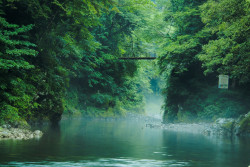
November 17, 2017
The Three Pleasures
A reporter investigates Japanese-Canadian internment camps in WWII
It is a truth universally acknowledged that Canada is nice. It’s all maple syrup and dashing Mounties and Justin Trudeau. But this image is a relatively recent one, belying Canada’s colonial history—its appalling treatment of the indigenous people and its racist past. The Mounties are police, after all, and don’t let Justin’s dreamy hair distract from the fact that he reneged on his environmental promises and signed two major oil pipelines into being. The maple syrup is still good, though.
Terry Watada’s novel The Three Pleasures is set in and around one of these darker times: the Second World War. Ever since the late 1800s, a Japanese community had grown and flourished in Canada, mostly in Vancouver. A downtown area around Powell Street became known as Japantown and Little Tokyo (though it’s mostly the white people who call it that). The Japanese had been carried there by the Kuroshio, the black current that flows through the Pacific, and had made the true north (strong and free) their home. The Issei, the first and immigrant generation, were followed by the Nissei, the generation of Japanese born in Canada. It was this latter generation that considered themselves true Canadians, and the narrator of The Three Pleasures, Daniel Sugiura, firmly counts himself as one.
In 1941, when the book begins, Daniel is in his second year of study at the University of British Columbia in 1941. He’s studying English literature, and studiously ignoring the racism all around him—always present, but now rising as the war intensifies. Daniel is a natural recruit for the local Japanese newspaper, The New Canadian, which bears a mission statement that pledges itself to “the greatness of Canada and the part of the Canadian-born Japanese in this future.”
Daniel is drawn into the politics of Powell Street, into the realms of the three pleasures that the novel draws its title from: Etsu Kaga, Watanabe Etsui and Morii Etsuji. Kaga is a zealous young man, loyal still to the Emperor; Watanabe is a pillar of the community turned sell-out; Morii is a gang leader who’s insinuated himself in the Empires of both East and West. They represent the influences that push and pull at Issei and Nisei alike in the turbulent years that follow.
After Pearl Harbour, the suspicion of the Japanese deepens (in the US, especially). In Canada, the government names their Japanese citizens “enemy aliens” and in 1942 the evacuation begins.
Daniel reports on the destruction of the community, as their property is confiscated, and homes, families and lives are dissembled with shocking ease. The people are sent to the Canadian interior—far from that warm Kuroshio current—to internment camps that often have no running water, shelter or resources. Daniel travels from place to place, documenting and investigating under the protection of his journalist status, though there is a noticeable lack of examples of what he actually writes. Odd, because The New Canadian is both source and reason for the novel. Chapters begin with quotes drawn from it, a fascinating first-hand source that grants a glimpse into what is often an ironic sense of hope and trust that the Japanese have placed in the Canadian government.
It may be that form and content reflect each other too accurately: Daniel rarely loses the voice of a reporter, a style of narration that maintains an impassiveness even while relaying events that are highly emotional. Telling far outweighs showing, and it’s less engaging because of it. Watada is a poet as well as a fiction writer, and this is clear at the times when Daniel is moved to verse. He acquires an eloquence that says more in its abstraction than all of his accurate descriptions. It’s noticeable because, although the speech of the Issei and Nissei is redolent with Japanese words and phrases, voice and dialogue sometimes feel stiff and similar. It’s a stumbling block because the novel features a large cast, a long timeline and many miles of Canadian country. It’s difficult to hold all the characters in mind as politics deepen and conflicts grow. And perhaps it can be blamed on the time period, but there are few female characters, and fewer that exist full and developed, outside of the roles of tearful mothers and romantic interests.
There were points where it had to be asked: what does Daniel want and why and what is he doing about it? He spends much of the book as an observer and half-reluctant participant, and while this can be entirely effective for a protagonist, in The Three Pleasures there simply needs to be more arresting characters to observe. It’s at odds with the events, which are sinister and desperate and all the more relevant in a time like now, when governments turn against their citizens.
The Three Pleasures joins a short list of literature that examines this period of history, and writing that exposes prejudice, discrimination and harm is always worthy of a read. It’s a failing, though, that the novel’s fact-exposing style favours historical accuracy over the fiction that can make the past feel present. Shikataganai—it can’t be helped—was the ethic and comfort of the Japanese-Canadians whose homes were wrested from them, who became enemies and aliens in their own country. Perhaps it’s this feeling of inevitability that colours the novel. It’s true that history can’t be changed. It can, however, be retold. Perspectives can change and hushed voices can be made loud. The Three Pleasures had the opportunity to show that, but it falls short with its newspaper tone. It’s a pity, because that’s the beauty of fiction; it’s a defiance of shikataganai and the inevitable—it changes freely and can enact change itself.







